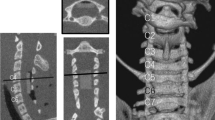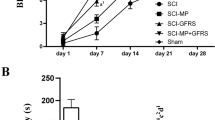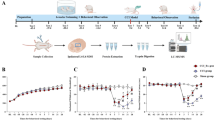Abstract
Study design
Experimental animal study.
Objectives
To assess the feasibility of a custom-designed parallel-moving (PM) clip, compared with a single-axle-lever (SAL) clip, for the development of a compressional spinal cord injury (SCI) model in rats.
Setting
Hospital laboratory in China.
Methods
We used a PM clip and a SAL clip with same compression rate, to develop a SCI model in rats, and set a sham group as a blank control. Within 3 weeks, each group of rats was evaluated for behavioral (Basso–Beattie–Bresnahan locomotor rating score, BBB), and electrophysiological changes (somatosensory evoked potential), and historical staining to observe the differences between the three groups. In particular, the mechanical results of the PM group were calculated.
Results
The BBB scores for the SAL and PM groups were significantly lower than those for the sham group (P < 0.05), no significant difference between the two methods (P > 0.05), but the values corresponding to the PM group had smaller standard deviations. The interpeak-latency (IPL) was significantly prolonged (P < 0.0001) and the peak-peak amplitude (PPA) was significantly reduced (P < 0.01) in SAL and PM groups than those in the sham group, but there was no statistical difference in both IPL and PPA between the two SCI groups (P > 0.05). Histological staining showed obvious pathological changes in two SCI groups, and the shape of the lesion zone in the PM group was more symmetrical than that in the SAL groups.
Conclusions
The use of a compressional SCI model in rats with the PM clip we designed is an appropriate method to quantify the injury. The degree of the injury caused by this clip is more stable and uniform than those with classical methods.
Similar content being viewed by others
Log in or create a free account to read this content
Gain free access to this article, as well as selected content from this journal and more on nature.com
or
References
Ramer LM, Ramer MS, Bradbury EJ. Restoring function after spinal cord injury: towards clinical translation of experimental strategies. Lancet Neurol. 2014;13:1241–56.
Kretzer, RM. A clinical perspective and definition of spinal cord injury. Spine (Phila Pa 1976). 2016;41:S27.
Cannon B. Sensation and loss. Nature. 2013;503:S2.
Liu D, Chen J, Jiang T, Li W, Huang Y, Lu X, et al. Biodegradable spheres protect traumatically injured spinal cord by alleviating the glutamate-induced excitotoxicity. Adv Mater. 2018;30:e1706032.
Rivlin AS, Tator CH. Effect of duration of acute spinal cord compression in a new acute cord injury model in the rat. Surgical Neurol. 1978;10:38–43.
Lv H, Yang J, Liao Z, Zhao Y, Huang Y. NG2 expression in rats with acute T (10) spinal cord injury. Neural Regen Res. 2012;05:41–44.
Cheriyan T, Ryan DJ, Weinreb JH, Cheriyan J, Paul JC, Lafage V, et al. Spinal cord injury models: a review. Spinal Cord 2014;52:588–95.
do Espírito Santo CC, da Silva Fiorin F, Ilha J, Duarte MMMF, Duarte T, Santos ARS. Spinal cord injury by clip-compression induces anxiety and depression-like behaviours in female rats: The role of the inflammatory response. Brain Behav Immun. 2019;78:91–104.
Chamankhah M, Eftekharpour E, Karimi-Abdolrezaee S, Boutros PC, San-Marina S, Fehlings MG. Genome-wide gene expression profiling of stress response in a spinal cord clip compression injury model. BMC Genomics. 2013;14:583.
Poon PC, Gupta D, Shoichet MS, Tator CH. Clip compression model is useful for thoracic spinal cord injuries: histologic and functional correlates. Spine (Phila Pa 1976). 2007;32:2853–9.
Abdullahi D, Annuar AA, Mohamad M, Aziz I, Sanusi J. Experimental spinal cord trauma: a review of mechanically induced spinal cord injury in rat models. Rev Neurosci 2017;28:15–20.
Ichikawa Y, Nishimoto T, Niwa K. TAILSTOCK CONTROL DEVICE, US20090199685[P]. 2009.
Vaughn CN, Iafrate JL, Henley JB, Stevenson EK, Shlifer IG, Jones TB. Cellular neuroinflammation in a lateral forceps compression model of spinal cord injury. Anat Rec (Hoboken). 2013;296:1229–46.
Khaing ZZ, Cates LN, DeWees DM, Hannah A, Mourad P, Bruce M, et al. Contrast-enhanced ultrasound to visualize hemodynamic changes after rodent spinal cord injury. J Neurosurg Spine. 2018;29:1–8.
Guo J, Cao G, Yang G, Zhang Y, Wang Y, Song W, et al. Transplantation of activated olfactory ensheathing cells by curcumin strengthens regeneration and recovery of function after spinal cord injury in rats. Cytotherapy. 2020;22:301–12.
Sharif-Alhoseini M, Khormali M, Rezaei M, Safdarian M, Hajighadery A, Khalatbari MM, et al. Animal models of spinal cord injury: a systematic review. Spinal Cord. 2017;55:714–21.
Rong H, Liu Y, Zhao Z, Feng J, Sun R, Ma Z, et al. Further Standardization in the Aneurysm Clip: The Effects of Occlusal Depth on the Outcome of Spinal Cord Injury in Rats. Spine. 2018;43:E126–E131.
McDonough A, Monterrubio A, Ariza J, Martínez-Cerdeño V. Calibrated forceps model of spinal cord compression injury. J Vis Exp. 2015;98:52318.
Plemel JR, Duncan G, Chen KW, Shannon C, Park S, Sparling JS, et al. A graded forceps crush spinal cord injury model in mice. J Neurotrauma. 2008;25:350–70.
Usmani S, Franceschi Biagioni A, Medelin M, Scaini D, Casani R, Aurand ER, et al. Functional rewiring across spinal injuries via biomimetic nanofiber scaffolds. Proc Natl Acad Sci USA. 2020;117:25212–8.
Agrawal G, Kerr C, Thakor NV, All AH. Characterization of graded mascis contusion spinal cord injury using somatosensory evoked potentials. Spine. 2010;35:1122–7.
Rowland JW, Hawryluk GW, Kwon B, Fehlings MG. Current status of acute spinal cord injury pathophysiology and emerging therapies: promise on the horizon. Neurosurg Focus. 2008;25:E2.
Denis F. The three column spine and its significance in the classification of acute thoracolumbar spinal injuries. Spine. 1983;8:817–31.
Ahmed RU, Alam M, Zheng YP. Experimental spinal cord injury and behavioral tests in laboratory rats. Heliyon. 2019;5:e01324.
Acknowledgements
The authors thank AiMi Academic Services (www.aimieditor.com) for the English language editing and review services.
Funding
This work was supported by the National Natural Science Foundation of China (81830077).
Author information
Authors and Affiliations
Contributions
XHW was responsible for designing the protocol, writing the protocol, design the device for surgery, participate in experimental operation, evaluating and writing the article; CJ was responsible for improving the experimental ideas and writing the protocol, participate in experimental operation in each tests, result collection and result analysis; YYZ and ZC guiding the modeling surgery, screening potentially eligible studies; ZYW assisted in the operation, recording partial postoperative indicators; HY help us solving some technical problems encountered; DJH providing financial support.
Corresponding author
Ethics declarations
Competing interests
The authors declare no competing interests.
Ethical approval
We certify that all experimental procedures were performed in accordance with the Guide of Laboratory Animal Care and Use from the United States National Institution of Health and were approved by the Institutional Animal Care and Use Committee (IACUC) of Xi’an Jiaotong University, SN, China.
Additional information
Publisher’s note Springer Nature remains neutral with regard to jurisdictional claims in published maps and institutional affiliations.
Rights and permissions
About this article
Cite this article
Wang, Xh., Jiang, C., Zhang, Yy. et al. Analysis and comparison of a spinal cord injury model with a single-axle-lever clip or a parallel-moving clip compression in rats. Spinal Cord 60, 332–338 (2022). https://doi.org/10.1038/s41393-021-00720-7
Received:
Revised:
Accepted:
Published:
Issue date:
DOI: https://doi.org/10.1038/s41393-021-00720-7
This article is cited by
-
Rho Kinase Inhibitor Y27632 Improves Recovery After Spinal Cord Injury by Shifting Astrocyte Phenotype and Morphology via the ROCK/NF-κB/C3 Pathway
Neurochemical Research (2022)
-
The Anti-inflammation Property of Olfactory Ensheathing Cells in Neural Regeneration After Spinal Cord Injury
Molecular Neurobiology (2022)



